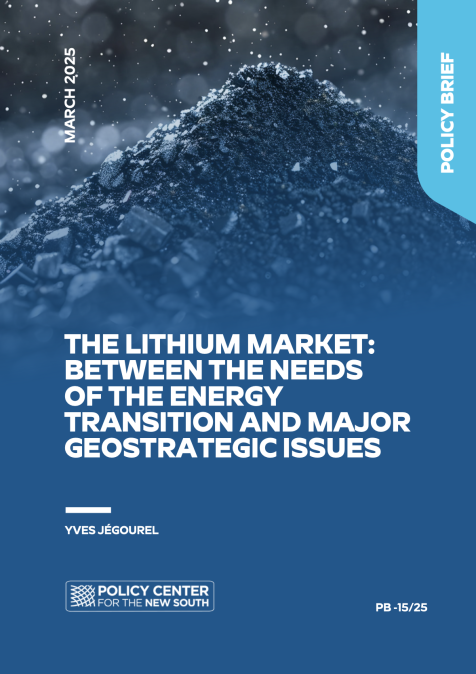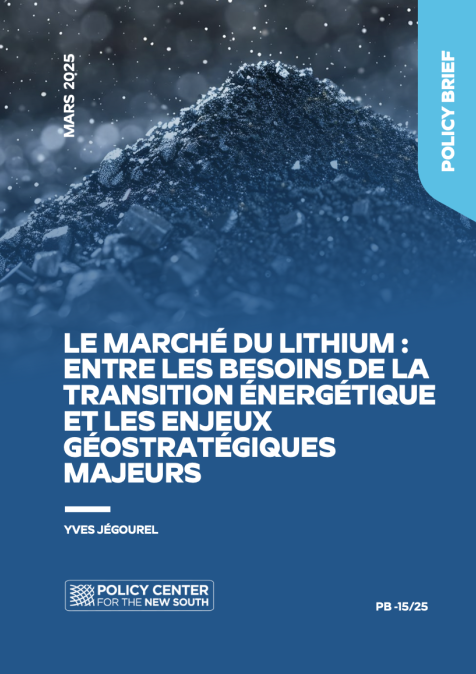Publications /
Opinion
Earlier this month, the World Resources Institute based in Washington D.C. revealed that 17 countries, home to one-quarter of the world's population, are facing extremely high water stress. Below is an international press review of the global water crisis by Helmut Sorge, former Foreign editor, and Middle East expert for Germany's leading newsmagazine "Der Spiegel", and columnist at the Policy Center for the New South.
“A QUARTER OF THE WORLD IS FACING A LOOMING WATER CRISIS”
“Not only is the Egyptian climate peculiar to that country, and the Nile different in the way it behaves from rivers elsewhere, but the manners and customs of the Egyptians themselves seem to be the opposite of the typical practices of mankind.” Herodotus.
The Nile is more than just a river, as the ancient Greek historian (484-425 BC) described. The Nile is history and, also, one of the longest rivers in the world, 4100 miles from the river’s feeding Lake Victoria to the Mediterranean Sea. The sources of the Blue and the White Nile, (which merge in Sudan’s Khartoum, 2250 km south of Cairo), Lake Victoria and Lake Tana, are located far away, in distant nations named Ethiopia, and further south, Uganda, Tanzania and Kenya. The Nile is Egypt, the foundation of its civilization, in which the pharaohs reigned as Gods, worshipped and feared by the people. Egypt was nothing less than a gift by the Nile, because without the water, there would have been no agriculture greening the desert, the brown layer of silt that the Nile left when it flooded the river banks for a few months a year, leaving behind alluvial soil, nutrients, natural fertilizers created by nature and not industrial chemical giants, allowing the farming of wheat and barley. The Nile was the source of historical discoveries, the earliest form of paper for example, papyrus, a thin paper material made by cutting reed collected from the river.
THE NILE-A CAUSEWAY FROM LIFE TO DEATH
A civilization blessed by nature, the ever returning flow of water, the rules of the spirits and the gods, assisting the pharaohs, themselves gods, in the rule of the desert kingdom the upper and the lower Egypt. The east coast of the Nile was thought to be a representation of birth and life, and the west coast was thought to symbolize death, explaining why all tombs and pyramids are built on the west bank. Most of the population and cities of Egypt lie along those parts of the Nile valley north of Aswan and nearly all the cultural and historical sites of ancient Egypt are found along river banks, its population convinced that the Nile was the causeway from life to death and –return. Even the pharaoh could die, buried forever in his pyramid, but in reality returning as a god, as Osiris, the god of death. There were thousands of spirits influencing life and thought, and gods for all times of the day, responsible for nature, the sun, death, and moisture. Hapi was the god for the annual floods, which Egyptian scientists tried to predict through astronomy. They discovered that when Sirus, the brightest star, rose in front of the sun in the morning of the summer solstice (when the sun reaches its highest or lowest point), the annual flood would occur. The event would be marked as day 1 of their calendar year. Once upon a time, thousands of years ago, Egypt was not only blessed by Hapi, but his colleague, the Nile goddess Anuket, the nourisher of the fields, whose spiritual powers kept those summer floods coming.
Times, helas, are changing. The gods of floods and moisture, apparently abandoned the blessed nation of Egypt, no, the WHOLE world. The earth is running out of water, the vital element for all life. Rivers are drying out, the flooding of the river banks of the Nile have largely ceased, since the Aswan dam is controlling the flow since 197O. The silt and sediment that used to flow north, enriching the soil, is now building up behind the dam. Instead of growing in size through the soil deposits, the delta is “now shrinking due to erosion along the Mediterranean Sea (“National Geographic”), and since routine annual flooding, necessary to flush and clean the water of human and agricultural waste, no longer occurs along parts of the Nile, the water is becoming more polluted.” Canals still bring water from the Nile to irrigate farms and support cities—95 percent or Egyptians live within a few kilometers of the Nile. Do they still believe in Tefnut, the Goddess of moisture and rain, imagined in ancient days as a human with the head of a lioness? Today, writes Ayah Aman in her impressive report on the dwindling, troubled Nile, published by the web magazine “al Monitor”, the descendants of ancient Egypt are “more likely to seek solace from Allah and irrigation agency bureaucrats.”Surging population growth along the Nile compounded by the devastating impact of climate change “threatens disaster”, believes author Aman, as more and more people compete for a disappearing resource, the Nile water. Today, she researched, Egypt faces an annual water deficit of more than 20 billion cubic meters.
THE NILE THREATENS TO DRY UP
Despite being a national priority reports Ayah Aman, the agricultural world is one of the hardest hit victim as Egypt runs out of water and the Nile threatens to dry up. Since 1991 employment in the agricultural sector has dropped from 44 percent to less than 27 percent, in part due to farmers abandoning their unprofitable lands to look for work elsewhere. Water levels are falling since the heavy rainfall in the mountains of Ethiopia, the major source of Nile water, flowing more than 1500 miles downstream to bring the Egyptian desert to life, have failed the farmers more often than once, at times the Blue Nile even dries out. At the river banks no water, just tears of farmers. In Cairo, the capital, reports Ayah Aman, urbanites struggle with weak water pressure and garbage clogged canals. Along the rivers bank abandoned boats attest to a dying fish industry. Scientists estimate that half of all fish species have vanished from the lower Nile, many have disappeared from the Egyptian waters just in the past five decades, with the construction of the Aswan dam being blamed impeding fish reproduction and blocking the flow of sediment 1000 miles downstream. That in turn, writes Ayah Aman, “has caused the Nile Delta to recede and the Mediterranean salty waters to advance- a devastating effect.”
Fish farming now makes up 80 percent of Egypt’s fish production, mostly Nile tilapia, grey mullet and carp. Water scarcity is causing problems in this economic challenge as well- every kilogram of farmed fish requires 6600 gallons of water to produce putting more strain on the scarce resources, according to a 2016 study published by “Aquaculture International.” Floating cages in the Nile itself is no longer an option , the study confirmed, as the river is “polluted from inorganic nitrogen, organic substances, phosphorous and heavy metals.” Ayah Aman: “The countries failure to feed its people has transformed the former breadbasket of the Roman Empire into the world ‘s largest wheat importer”. Egypt imported 12.5 million metric tons of wheat and flour from April 2018 to April 2019, 50 percent more than it produced.” To make matters worse”, states Mrs Aman, farmers are increasingly growing crops in the desert as the country loses fertile land to urbanization”—and no spirit returning from a few lost thousand years, the goddess Tefnut, in charge of moisture and rain, just the confirmation of Mohamed Abdel Ati, the Minister of Water Resources and Irrigation, that “we have reached a point where the available water quantities set the limits for economic development. We have become one of the driest countries in the world.”
HIGH BASELINE WATER STRESS
The newest “National Water Stress Rankings”, revealed early this month by the Washington based “World Resources Institute” will hardly be of relief for the government official; his thirsty nation is positioned 43rd under the heading “High baseline water stress”, one place above Italy, in the same group as Morocco, Algeria, Tunisia, Syria, Turkey and Iraq. The findings of the Institute are alarming-not only being 10 of the 17 selected “Extremely high baseline water stressed nations” located in the MENA regions, Qatar, Israel, Lebanon, Jordan, Libya, Kuwait, Saudi Arabia, United Arab Emirates, Bahrain and Oman, but it seems probable that growing demand will push these MENA countries towards extreme stress situations-with dangerous consequences. The world Bank predicted that the region will suffer the greatest expected economic losses from climate related water scarcity, estimated at 6-14 percent of GDP by 2050. The headline of the “New York Times“ front page was alarming enough, “A QUARTER OF HUMANITY FACES LOOMING WATER CRISIS”. Yet, if governments are unable or unwilling to deal with the crisis (as the recycling of wastewater, the harvesting of rainwater, lakes be cleaned up, farmers can switch from water intensive crops like rice to crops like millet, investments in infrastructure, construction of treatment plants, improvement of irrigation techniques) social unrest may be unavoidable as will be a growing global migration…
Today, among cities with more than three million inhabitants, “World Resources Institute” researchers concluded, 33 of them, with a combined population of over 255 million, face extremely high water stress, “with repercussions for public health and social unrest” (“New York Times”). In past months, cities like Sao Paolo (Brazil), Chennai (India), and Capetown (South Africa) made it into global headlines—acute shortage of water. Mexico City is drawing groundwater so fast that the city is sinking. Capetown faced empty swimming pools, rationed showers, with no immediate solution. All dams, even the one functional, were empty. Faced with day zero, meaning zero water. Thirst and dust and one shower—may be Christmas. By 2030, the numbers of cities in the extremely high water stress category is expected to rise to 45 and will include nearly 470 million people, Cairo probably included. Unless the Gods return, at least one, Anuket, trained in flooding fields.





